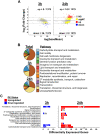Borrelia burgdorferi, the Lyme disease spirochete, possesses genetically-encoded responses to doxycycline, but not to amoxicillin
- PMID: 36178885
- PMCID: PMC9524633
- DOI: 10.1371/journal.pone.0274125
Borrelia burgdorferi, the Lyme disease spirochete, possesses genetically-encoded responses to doxycycline, but not to amoxicillin
Abstract
Some species of bacteria respond to antibiotic stresses by altering their transcription profiles, in order to produce proteins that provide protection against the antibiotic. Understanding these compensatory mechanisms allows for informed treatment strategies, and could lead to the development of improved therapeutics. To this end, studies were performed to determine whether Borrelia burgdorferi, the spirochetal agent of Lyme disease, also exhibits genetically-encoded responses to the commonly prescribed antibiotics doxycycline and amoxicillin. After culturing for 24 h in a sublethal concentration of doxycycline, there were significant increases in a substantial number of transcripts for proteins that are involved with translation. In contrast, incubation with a sublethal concentration of amoxicillin did not lead to significant changes in levels of any bacterial transcript. We conclude that B. burgdorferi has a mechanism(s) that detects translational inhibition by doxycycline, and increases production of mRNAs for proteins involved with translation machinery in an attempt to compensate for that stress.
Conflict of interest statement
The authors have declared that no competing interests exist.
Figures




Similar articles
-
Drug combinations against Borrelia burgdorferi persisters in vitro: eradication achieved by using daptomycin, cefoperazone and doxycycline.PLoS One. 2015 Mar 25;10(3):e0117207. doi: 10.1371/journal.pone.0117207. eCollection 2015. PLoS One. 2015. PMID: 25806811 Free PMC article.
-
Comparative in vitro and in vivo susceptibilities of the Lyme disease spirochete Borrelia burgdorferi to cefuroxime and other antimicrobial agents.Antimicrob Agents Chemother. 1990 Nov;34(11):2133-6. doi: 10.1128/AAC.34.11.2133. Antimicrob Agents Chemother. 1990. PMID: 2073103 Free PMC article.
-
Therapy for Lyme arthritis: strategies for the treatment of antibiotic-refractory arthritis.Arthritis Rheum. 2006 Oct;54(10):3079-86. doi: 10.1002/art.22131. Arthritis Rheum. 2006. PMID: 17009226 Review. No abstract available.
-
Kill kinetics of Borrelia burgdorferi and bacterial findings in relation to the treatment of Lyme borreliosis.Infection. 1996 Jan-Feb;24(1):9-16. doi: 10.1007/BF01780643. Infection. 1996. PMID: 8852456
-
[Diagnostics and treatment of Lyme borreliosis].Duodecim. 2000;116(6):605-12. Duodecim. 2000. PMID: 11787113 Review. Finnish. No abstract available.
References
-
- Wormser GP, Dattwyler RJ, Shapiro ED, Halperin JJ, Steere AC, Klempner MS, et al.. The clinical assessment, treatment, and prevention of Lyme disease, human granulocytic anaplasmosis, and babesiosis: Clinical practice guidelines by the Infectious Diseases Society of America. Clin Infect Dis. 2006;43:1089–134. doi: 10.1086/508667 - DOI - PubMed
Publication types
MeSH terms
Substances
Grants and funding
LinkOut - more resources
Full Text Sources
Medical
Molecular Biology Databases

